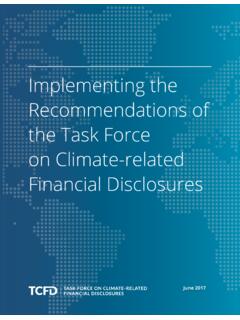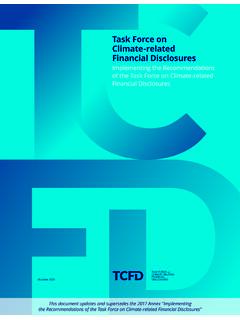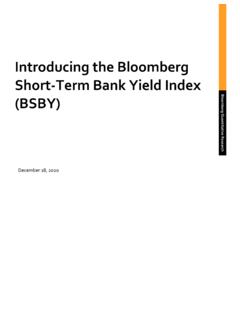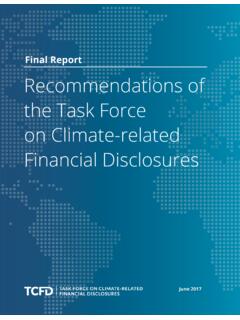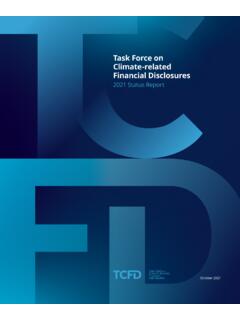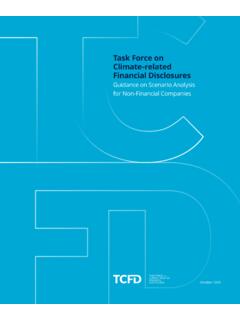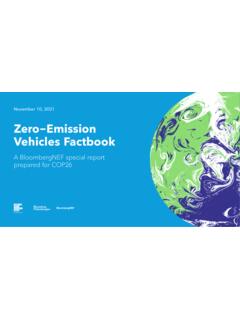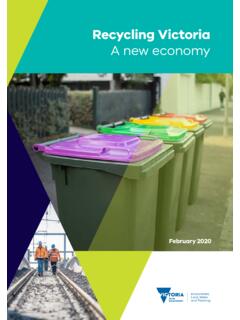Transcription of NEO 2021 Executive Summary - assets.bbhub.io
1 Executive Summary Bloomberg Finance No portion of this document may be reproduced, scanned into an electronic system, distributed, publicly displayed or used as the basis of derivative works without the prior written consent of Bloomberg Finance For more information on terms of use, please contact Copyright and Disclaimer notice on page 17 applies Executive Summary Bloomberg Finance No portion of this document may be reproduced, scanned into an electronic system, distributed, publicly displayed or used as the basis of derivative works without the prior written consent of Bloomberg Finance For more information on terms of use, please contact Copyright and Disclaimer notice on page 17 applies throughout. 2 Preamble The New energy Outlook (NEO) is BloombergNEF s annual long-term scenario analysis on the future of the energy economy.
2 In this edition we present scenarios that reach net-zero emissions in 2050 and achieve the goal of the Paris Climate Agreement, reflecting growing interest in climate pathways. With much of the route to net-zero still uncertain, we have designed three climate scenarios that reflect dominant technology paradigms common in the public discourse. We investigate these energy futures and discuss what it means to get on track for net-zero by 2030. We hope this year's analysis is a valuable input to support strategy development and long-term planning, especially in the lead-up to COP26 in November. Each of our scenarios combines greater electrification, clean electricity and energy storage batteries, along with a major complementary decarbonization technology hydrogen, carbon capture and storage , or nuclear power.
3 There is also a role for bioenergy, recycling , efficiency improvements and carbon removals. Our Green Scenario is a clean-electricity and green-hydrogen net-zero pathway. Here, hydrogen produced from water using electrolyzers powered by wind and solar is applied in sectors such as industry and heavy transport, as well as in power generation to complement electrification. Our Gray Scenario is a clean-electricity and carbon-capture-and- storage (CCS) net-zero pathway. In this scenario, in addition to growth in electricity use and renewable power, emissions from fossil fuels in some sectors are abated using post-combustion carbon capture and storage technology. It also includes small amounts of so called blue hydrogen produced from natural gas with carbon capture technology for use in non-stationary energy applications, and greater use of bioenergy.
4 And finally, our Red Scenario is a clean-electricity and nuclear net-zero pathway. This one follows a similar trajectory to the Green Scenario except that we deploy small, modular nuclear to complement wind, solar and battery technology in the power sector, and add so-called red hydrogen , which is manufactured using electrolysis as in our Green Scenario, but this time powered by dedicated nuclear power plants. In practice, we will probably see a mix of these solutions as each country pursues climate strategies that best suit them, considering their existing domestic economy, international trade and geopolitics. Country-specific climate pathways will be one focus of subsequent iterations of the New energy Outlook. This report is split into three parts. Part 1: The Carbon Budget describes sector-by-sector emissions budgets needed to keep climate change well below two-degrees above pre-industrial levels and reach net-zero emissions in 2050.
5 Part 2: Net-Zero Scenarios describes the three scenario results in detail, breaking out each sector of the energy economy. It includes long-run growth in electricity, renewables, and batteries, as well as the opportunity for hydrogen, carbon capture and storage , and nuclear. And Part 3: The Next 10 Years translates our net-zero pathways into near-term actions to get on track by 2030. Executive Summary Bloomberg Finance No portion of this document may be reproduced, scanned into an electronic system, distributed, publicly displayed or used as the basis of derivative works without the prior written consent of Bloomberg Finance For more information on terms of use, please contact Copyright and Disclaimer notice on page 17 applies throughout. 3 Figure 1: Overview of three net-zero scenarios described in NEO 2021 Source: BloombergNEF The carbon budget energy emissions rose year-on-year in the five years to 2020.
6 Based on current trends, we are on track to run out of emissions budget to stay within 2 degrees of warming in 2044. And as soon as 2028, we will have exhausted the emissions budget to stay within degrees. This underlines the need for immediate, concrete policy action to accelerate decarbonization today: achieving mid-century climate goals will not be sufficient, unless intermediate milestones are also hit. To achieve global net-zero, every sector of the energy economy needs to eliminate emissions completely by mid-century. There can be no free riders. Even the hardest-to-abate sectors will need to adopt carbon-free solutions, only turning to carbon removals where absolutely necessary. We have constructed net-zero carbon budgets for each sector of the energy economy that achieves the Paris Climate Agreement and satisfies the principle of an orderly transition, with the rate and timing of abatement varying depending on current emissions trajectory and available abatement options in the near term.
7 The resultant budget requires emissions to fall 30% below 2019 levels by 2030, and to drop 75% by 2040 to reach zero in 2050. The power sector goes fastest, following a equivalent budget that sees emissions down 57% from 2019 levels in 2030, and then 89% in 2040. Road transport emissions drop 11% by 2030 before this accelerates during the 2030s to reach 80% below 2019 levels in 2040. Residential and commercial buildings follow a more linear trajectory, down 16% below 2019 levels by 2030 and 58% by 2040. Harder-to-abate sectors such as aviation, steel and cement go slowest, capping emissions growth this decade before a linear decline to zero mid-century. Executive Summary Bloomberg Finance No portion of this document may be reproduced, scanned into an electronic system, distributed, publicly displayed or used as the basis of derivative works without the prior written consent of Bloomberg Finance For more information on terms of use, please contact Copyright and Disclaimer notice on page 17 applies throughout.
8 4 Figure 2: Total carbon budget for the energy sector Source: BloombergNEF Getting on track to 2030 The years between now and 2030 are critical in the race to net zero. For the world to get on track, there will need to be an immediate, unprecedented acceleration in deployment of existing technologies, such as renewable energy and electric vehicles. In parallel, new technologies need to be commercially demonstrated and scaled up, in order to be ready for massive deployment before the decade is out. More than three quarters of the abatement effort in this period falls to the power sector and the faster deployment of wind and solar PV. Another 14% is achieved via greater use of electricity in transport, building heat and to provide lower-temperature heat in industry. Greater recycling in steel, aluminum and plastics accounts for 2%, and growth of bioenergy for sustainable aviation fuel and shipping another 2%.
9 Getting on track for the power sector, means adding up to 505GW of new wind, 455GW of new solar and 245 GWh new battery storage on average every year to 2030 under our Green Scenario. This is over the amount of wind capacity added in 2020, the amount of solar and 26-times the amount of battery storage . By 2030, that adds up to a total of of installed wind, of installed PV, and of batteries. These totals are up eightfold, ninefold and 176-fold from 2020 levels, respectively. At the same time, around 125GW of coal-fired capacity needs to retire on average each year so that by 2030 coal-fired power is 67-72% below 2019 levels. Capital flows need to accelerate markedly too. New investment in wind and solar capacity has been flat at around $300 billion per year for several years.
10 This figure needs to rise to between $763 billion to $ trillion per year between 2021 and 2030 depending on scenario, to get on track for net zero. Getting on track for transport means adding an average of 35 million electric vehicles each year so that by 2030 there are 355 million EVs in 2030 and emissions from the road segment are 11% below 2019 levels. At the same time, sustainable aviation fuels need to increase to Emission budgetEconomic Transition Scenario05101520253035201220202025203020 35204020452050 GtCO2 PowerEnergy industryOtherAviationShippingRoadCommerc ialResidentialOther IndustryPetrochemicalsCementAluminumStee l Executive Summary Bloomberg Finance No portion of this document may be reproduced, scanned into an electronic system, distributed, publicly displayed or used as the basis of derivative works without the prior written consent of Bloomberg Finance For more information on terms of use, please contact Copyright and Disclaimer notice on page 17 applies throughout.



